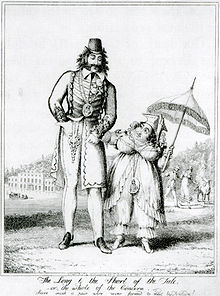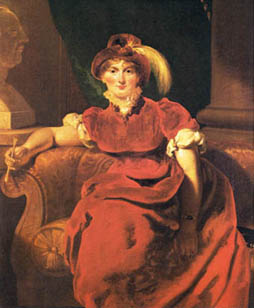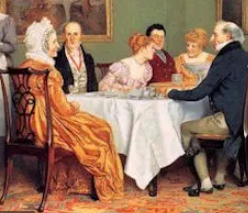The Prince Regent – “Prinny” – made no secret of his reluctance to marry Princess Caroline of Brunswick. Some years before he had secretly married Mrs. Maria Fitzherbert, a Catholic widow and the woman he loved. But according to the Royal Marriage Act their union was illegal. Princess Caroline, the daughter of Prinny’s eldest aunt AND a Protestant, was considered a more suitable consort by King George III. This proposed union with his cousin went much against the Prince’s wishes, and when he met the 27-year-old German Princess in 1795, he turned to Lord Malmesbury and said, “Harris, I am not well. Pray, get me a glass of brandy.”
The Prince of Wales had acquiesced to his father’s wishes only to clear his debts, which totaled £630,000 pounds, a staggering sum for that era, and for an increase in his yearly allowance. Although Prinny’s first impression of Caroline was unfavorable, she was thought to be quite pretty in her youth. The Prince, who was soft and fat, made an equally distasteful first impression on the Princess, and thus the couple, both spoiled and eccentric (to put it mildly) were off to a bad start. During the ceremony Prinny continually looked at his mistress, Lady Jersey, instead of his wife, and at one point the King had to persuade the Prince to finish the ceremony.
The marriage ceremony proceeded as arranged, attended by his well pleased father, on the evening of 8th April, 1795 at the Chapel Royal at St. James’ Palace. The bride wore a elaborate dress of silver tissue and lace and a velvet robe lined with ermine. The distraught bridegroom spent his wedding night lying on the bedroom floor by the fireplace in a drunken stupor.
Although he was repelled by his wife, George eventually did his duty and brought himself to consummate the marriage and the Princess of Wales gave birth to a daughter and heir to the throne, Princess Charlotte, on 7th January, 1796.” – English monarchs
Although not entirely unattractive, Princess Caroline was neither graceful nor elegant, nor did she behave in a regal fashion. Her “clumsy deportment and jerky movements made one MP liken her to a “Fanny Royds” (a weighted Dutch doll with red cheeks that jumps up to standing position)” – Historicizing Romantic Sexuality. Her German manners and demeanor never quite came up to English royal expectations or their level of “sophistication.” Lady Jersey, the Prince’s mistress at the time, was cruel enough to wear a pair of pearl bracelets in front of Caroline that the Prince had originally presented to his bride as a wedding gift. He then took the jewelry back and gave the bracelets to Lady Jersey. The cartoon in the first image, which is sympathetic towards Caroline’s marital situation, shows Lady Jersey as an old hag welcoming a virginal Caroline to England.
In her youth Caroline could look quite presentable. A contemporary described her as being
… above the middle height, extremely spread for her age, her bosom full but finely shaped, her shoulders large, and her whole person voluptuous, but of a nature to become soon spoiled; and without much care and exercise she will shortly lose all beauty in fat and clumsiness. Her skin is white but not a transparent white. There is little or no shade in her face, but her features are very fine. Their expression like that of her general demeanour is noble. Her feet are rather small, and her hands and arms are finely moulded She has a hesitation in her speech amounting almost to a stammer … – Memoirs of the Court of England During the Regency (1811-1820)
Observers did agree on several aspects about Caroline: her manners could be coarse and gruff, and her taste in dress was atrocious. Mary Berry described the princess in her journal: “Such an over-dressed, bare-bosomed, painted eye-browed figure one never saw”. She flouted convention, “even if this meant exposing her decidedly lustful nature”; this rebellious streak, accompanied by her “outlandish ways and bizarre dress sense” combined to give Caroline an eccentricity not becoming in a female member of the British court, let alone its royal family.” – Elizabeth Fay, Historicizing Romantic Sexuality. As Caroline aged, her penchant for wearing virginal gowns made her look ridiculous and she became a target for satirists, as in the image below.
Caroline, who flaunted her unconventional and ribald tastes, surrounded herself with people of questionable morality.
The Princess evidently preferred gay company, a certain sprinkling of intelligence with a good flow of animal spirits being the ordinary passports to her society. No questions appear to have been asked of either sex; it is therefore not surprising that several of the favoured circle were celebrated more or less for their independence of moral obligations.” – Memoirs of the Court of England During the Regency (1811-1820)
The Duke of Buckingham and Chandos observed of her childhood: “Her faults have evidently never been checked nor her virtues fostered.” The Princess remained capricious and lewd all her life, and her risque conversations kept her attendants in daily dread of her impetuous pronouncements.
Caroline was – in her husband’s eyes – expendable. He thought her an unfit wife and mother and permitted her to see her daughter Princess Charlotte only once a week. Prinny’s reluctance to live with his wife and daughter, his politics, and his profligate ways made him unpopular with the public. Princess Caroline made the most of this situation, publicly playing the role of victim, even though by contemporary accounts she did not demonstrate much affection for her daughter. The Queen’s Matrimonial Ladder, published in 1820, demonstrates how sympathetic many were to her plight as the Prince Regent’s ostracized wife. Jane Austen famously wrote: “Poor woman, I shall support her as long as I can, because she is a Woman and because I hate her Husband.”

Sartiric Cartoon: Princess Caroline shows up at the King's Theatre during the performance of Don Giovanni, reminding the Prince that he is married
Banned from the social gatherings at the Prince’s lodgings and at Carlton House, Caroline established a rival court at Kensington Palace and Blackheath. The strange marriage between this eccentric couple provided an endless source for gossip, for Caroline’s indiscretions (as well as Prinny’s) were public knowledge:
… her Royal Highness had associates of an infinitely lower grade to whom she often devoted herself with an abandonment of self respect that equally perplexed and disgusted the ladies of her suite. With such a Court, as may be imagined, the pursuits of the Princess were not remarkable for dignity were often remarkable for its violation.” – Memoirs of the Court of England During the Regency (1811-1820)
In 1814, Caroline moved to Europe, traveling to Germany and Switzerland, and living for some time in Italy. The Prince sent agents to spy on her in order to prove not only her unfitness as mother and wife, but the burden she placed on the privy purse as well. Her every movement was reported back to England. And there was much to report, for her randy behavior was shocking, so much so that the members of her English entourage left her one by one. She dyed her blond hair black, favored short, diaphanous dresses that were designed for women half her age (she was in her forties), bared her bosom and arms, and danced and partied until the wee hours of the morning. Caroline loved spectacles and grand entrances:
At Genoa, [she] drove through the streets in a phaeton with a child dressed as a cupid leading two tiny horses who pulled the shell-shaped carriage. Caroline was dressed in a body-revealing pink gauze bodice, short white skirt and pink-feathered headdress.” – Historicizing Romantic Sexuality
Lady Bessborough wrote a description of Caroline at a ball during this period:
The first thing I saw in the room was a short, very fat, elderly woman, with an extremely red face (owing, I suppose, to the heat) in a girl’s white frock looking dress, but with shoulder, back, and neck, quite low (disgustingly so) down to the middle of her stomach; very black hair and eyebrows, which gave her a fierce look, and a wreath of light pink roses on her head…I could not bear the sort of whispering and talking all round about…” – The Prince of Pleasure, J.B. Priestley
When she arrived in Milan, the peripatetic Caroline met Bartolomeo Pergami, a tall and handsome ex-soldier who became her chamberlain. She began an affair with him, treating him more like her consort than lover. Their brazen relationship opened an investigation into her behavior. Thirty-one Italian witnesses were called, resulting in the conclusion that Caroline had engaged in continued adulterous intercourse. The Two Green Bags illustration (below) comes with the following interpretation: “In this iconic caricature, George and Caroline are depicted as a pair of fat green bags, a clear reference to the green bags that contained the evidence collected against Caroline by the Milan commission. George is much fatter than Caroline, and his bag is girded by a garter belt, part of which hangs down in the manner of a limp penis.” Wikimedia Commons. The truth was that the Princess was happy with Pergami and would have been content to remain in Italy had she been provided with a handsome enough income. (At that time she received 35,000 pounds per year.)
Prinny, who did not bother to hide his many scandalous affairs from the public, was excessively cruel to Caroline when their daughter, Princess Charlotte, died in childbirth. Instead of contacting Caroline directly, she heard about her daughter’s death through secondary sources. When King George III finally died, Caroline returned to England to claim her rights as Queen. Arriving in Dover in June 1820, she was cheered by crowds as she traveled in triumph to London. The irony was that despite her outlandish behavior abroad, the public so hated George IV that they supported her with wild (almost blind) loyalty, burning bonfires in her honor and setting off illuminations. Caroline took full advantage of her popularity, showing up at public events as often as possible. Her celebrity did not deter George from seeking a formal separation and a divorce from his much loathed wife.

Caroline returns to England against much winded opposition (image from The Queen's Matrimonial Ladder)
He persuaded Lord Liverpool and his government to bring in an Act of parliament to deprive her of the title Queen and to declare the marriage “for ever wholly dissolved, annulled and made void”. The Whigs opposed the measure and their were public demonstrations against the new king.” – Historicizing Romantic Sexuality
The bill to deprive Caroline from her right, privileges, and pretension to Queen Consort was thrown out after weeks and weeks of political wrangling. Caroline, who was no fool, said: “No one cares for me in this business.” She appeared fully and royally dressed at King George’s coronation but was turned away from the doors of Westminster Abbey a number of times, as she tried repeatedly to enter several entrances with no success. This outrageous action resulted in further public demonstrations that ended when Caroline died suddenly on August 7th in 1821 of an unknown gastric disorder. She was 53.
More on the Topic

















[…] Jane Austen’s World has an account of the strange marriage of the Prince Regent and Princess Caroline of Brunswick. […]
A very strange marriage indeed. It’s hard to say which of the two was worse! Thank you, Vic, for the informative post.
Both of them seemed a bit mad. Perhaps they consumed too much wine in their lives.
Steamy Darcy
Really fascinating. I didn’t know any of that.
Seems like a dysfunctional marriage! Very sad to see Caroline or Prinny forced to live in such a marriage because of what was expected out of them, inspite of faults on both sides.
The illustrations in this post are priceless!
Mark Twain on Austen:”Whenever I take up Pride and Prejudice or Sense and Sensibility, I feel like a barkeeper entering the kindgdom of heaven.”
Wonderfully researched Vic. Personally, I think they were both spoiled and pompous and nuts!
[…] researching information for my post about the Prince Regent and his strange marriage to Princess Caroline of Brunswick, I ran across this obscure item – a play in two acts about Prinny named The First Gentleman, […]
I remember a 1996 Masterpiece Theater production called “A Royal Scandal” that depicted the marriage between these two. It was VERY amusing considering Richard E Grant played the Prince Regent.
http://en.wikipedia.org/wiki/A_Royal_Scandal
Very informative and detailed description of Jane Austen’s World.
The pack also offers features that should be considered carefully. Some of them come from a zipper, although some come with snap closure. If you are not familiar with the snap, then you look at the zipper. The characteristics of the material must match your needs. If you do not want pockets on the outside, then you’re looking for bags that come with pockets on the inside only.
This is really a wonderful blog. I have stolen a picture (I hope, you will forgive me) but made a link to your blog in tomorrow’s post (Don Giovanni) in my blog.
[…] interesting stories of that era). I say loosely partly for a pun but also because I’m sure you couldn’t have gotten George and Caroline in the same room together let alone seen them being as close as Annie Lennox and Hugh Laurie are in this […]